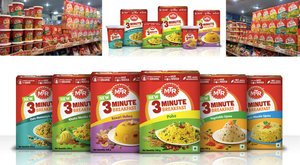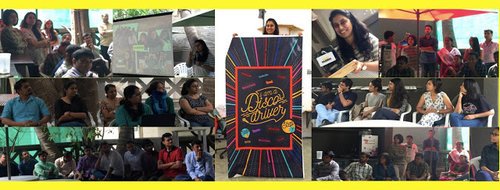Uger has designed sanitary pads for women that are made entirely in cotton. They can be washed at home and hence can be reused. This makes use of sanitary pads affordable to low income group women. And improves hygiene amongst these women. The pads come in pleasant colours and patterns. The inner stuffing is cotton that does not add to disposal and landfill issues. Pad making has given employment and work to women from the region. Laxmi Murthy has created value for women who are socio economically backward while mitigating environmental risks.
The second project is by Promethean Power Systems10, a start up. This project was done for the benefit of milk farmers in rural India. It demonstrates as to how technology led solutions can be created for people with lower resources and means.
Operation flood that was launched in India by the government has ensured that milk production has substantially increased at rural levels. Over 100 million gallons of milk is produced each year in India. However, milk requires immediate chilling otherwise in hot, humid conditions in regions like India, the milk quality diminishes in less than 4 hours. In India 10 million US$ worth of agricultural produce is lost due to inadequate cooling. In rural areas there is power only for 10 – 12 hours.
This affects milk chilling and the quality of milk, which in-turn reduces the earning by the farmer.
The new solution by Promethean Power Systems uses a Thermal storage battery that uses a phase change material to store and transfer chill energy. The battery charges up whenever the power supply is present and is ready to chill even when there is no power. This system ensures that there is chilling charge available in the system 24 hours, even when there is no electrical supply. Costly diesel set and stocking of fuel is avoided. The components are Modular and hence they can be easily transported in a small commercial vehicle. The bodywork is Stainless Steel, is hygienic. The loader platform ensures ease in pouring milk. What has this product achieved? It has made Making milk chilling affordable at community level. The farmers do not loose milk produce. The dairies get better quality of milk and the consumer gets healthy milk product.
Empowering communities to add value to their produce helps local communities grow and prosper. When we provide more value using fewer resources for more people our design efforts can be said to be truly working.
Design that helps sustain
There is an emergent need to shift the focus of design from the top 1% of the world population to the needs of rest of the world. This majority portion of the world faces complex problems in healthcare, energy needs, education, basic food & sanitation. Design has the potential to connect people with technology, people with people and businesses with people to reach out appropriate solutions that not only make lives better but help our planet to breathe.
Remote health care has started gaining importance in emerging economies. In countries like India, which fall short on resources, modes of travel, presence of primary health care, design and technology can come together to reach solutions and care to people who till today do not have access to good healthcare and diagnostics services. SynPhNe11 and Healthcubed are two such examples of new companies that are employing cutting edge technology and design to provide low cost, portable healthcare and diagnostics solutions to common people. Their design & technology may be based on local context but the solutions can help bring access to cutting edge healthcare and diagnostics to any person on our planet.
Talking of our planet, it is important to highlight the work of Daily Dump12, a Bengaluru, India based design led enterprise that has been using design to create eco friendly compositing solutions for organic waste. Daily Dumps work has helped change mind set of urban citizens towards waste segregation through effective use of design, local solutions and in the end it is a big step towards helping sustain our planet.
There is enough to be done for our planet and its habitants. As designers, we need to keep asking where we stand. I believe, It is our responsibility as a designer to sensibly keep giving more, by look for opportunities and understand that we can help make a large impact with design to the lives of common people, while sustaining our precious eco system.
Notes:
1. How much should a person consume? By Ramchandra Guha, 2010, Hachette India. Ramachandra Guha is an Indian historian and writer whose research interests include environmental, social, political and cricket history. For the year 2011–2012, he held a visiting position at the London School of Economics and Political Science (LSE), the Philippe Roman Chair in History and International Affairs. https://en.wikipedia.org/wiki/Ramachandra_Guha.
2. Devanagari, a script based on ancient Bramhi script family that has forty seven primary characters and is used for over 120 languages, https://en.wikipedia.org/wiki/Devanagari
3. Victor Papanek, Victor Joseph Papanek (22 November 1923 – 10 January 1998) was a designer, author and educator who became a strong advocate of the socially and ecologically responsible design of products, tools, and community infrastructures. http://papanek.org/about/victor-j-papanek/
4. Design for the real world, Victor Papanek, Academy Chicago Publishers (Preface to the first edition)
5. Mahindra & Mahindra is an automotive manufacturer, India, Reva & E2O, are all electric vehicles with zero tailpipe emission claims, http://mahindrareva.com
6. Tim Brown, CEO & President, IDEO, https://www.ideo.com/people/tim-brown, HBR Post, https://hbr.org/2015/08/when-everyone-is-doing-design-thinking-is-it-still-a-competitive-advantage
7. IIIT, Mumbai, Industrial Design Center, is a premier design school established in 1969, http://www.idc.iitb.ac.in
8. Electronics Corporation of India Limited (ECIL) is a Government of India Enterprise under the Department of Atomic Energy (India), established on April 11, 1967 by Dr A S Rao at Hyderabad, to create a strong indigenous base in electronics, http://www.ecil.co.in
9. UGER, means “new beginning”, UGER is a movement about women's empowerment and menstrual issues, http://ugerpads.jimdo.com, a brain child of designer, Laxmi Murthy
10. Promethean Power Systems, designs and manufactures refrigeration systems for cold-storage applications in off-grid and partially electrified areas of developing countries. http://www.coolectrica.com/#productsCoolectrica
11. SynPhNe is a Singapore based bio medical initiative, http://www.synphne.org
12. Daily Dump helps manage waste and garbage for home, http://www.dailydump.org
< Back to Blog

































